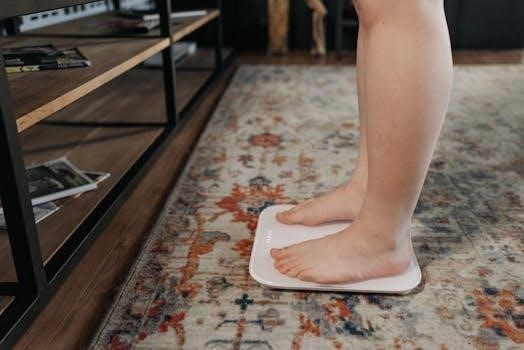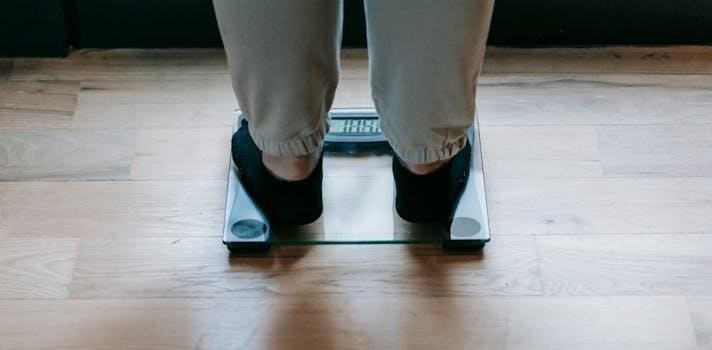Weight Watchers scales are designed to help users monitor their weight as part of a broader weight management program. These scales often come with various features, and it is important to read the included materials before using them to ensure correct use.
Overview of Weight Watchers Scales
Weight Watchers scales are available in various models, from basic weight-only scales to more advanced body analysis scales that measure body fat, muscle mass, and BMI. These scales are intended to be used in conjunction with the Weight Watchers weight loss program. Many modern Weight Watchers scales feature digital displays for easy reading and may have Bluetooth connectivity to sync data with a mobile app. The scales are designed for home use and usually require a flat, hard surface for accurate measurements. Some models also offer the ability to store user profiles for multiple individuals. Furthermore, these scales are often powered by batteries, and their capacity ranges up to 400 lbs. It is also important to note that some scales need to be set to pounds or kilograms according to user preference using a switch at the base of the scale.

Basic Operation of Weight Watchers Scales
Basic operation typically involves tapping the scale to turn it on, waiting for the display to show zeros, and then stepping onto the scale for a weight reading.
Turning the Scale On and Off
Weight Watchers scales are designed for ease of use, and turning them on is generally a simple process. Typically, you will need to tap the scale lightly with your foot or hand to activate it. The display will then light up, indicating that the scale is powered on and ready for use; Wait for the display to show all digits and then ‘0.0’ before stepping onto the scale. Some models may have a dedicated power button, which, if present, should be pressed to turn the scale on. To turn the scale off, most models will automatically shut off after a period of inactivity, usually a few seconds after the reading has been taken and displayed. There is generally no manual off switch on most standard models. If the scale does not turn on, check the battery and ensure that it is properly inserted. If issues persist, consider consulting the troubleshooting section of the manual.
Using the Weight Only Mode
Many Weight Watchers scales offer a ‘weight only’ mode, which is the most basic function for simply measuring your body weight. This mode is typically the default setting and does not require any programming. To use it, first, ensure the scale is powered on. Tap or press the activation button to start. After the display shows ‘0.0’, carefully step onto the center of the platform. Make sure to stand still and distribute your weight evenly to get the most accurate reading. The scale will then display your weight. This weight reading is the only information that will be provided in this mode, and there will be no additional body analysis data. Some scales may include a lock button on the bottom which must be switched to the ‘unlocked’ position for proper use. If the scale does not display a weight reading, check the battery or follow the troubleshooting steps.

Advanced Features and Customization
Weight Watchers scales often include advanced features like body analysis and Bluetooth syncing for a more comprehensive tracking experience. These features allow for customization to suit individual needs.
Customizing Body Analysis Settings
Many Weight Watchers scales offer the ability to customize body analysis settings to provide more personalized data. These settings often involve inputting personal information such as age, gender, and height to ensure accurate calculations of metrics like body fat percentage, muscle mass, and bone mass. To access these settings, refer to the specific model’s user manual, as the process may vary slightly between different devices. Typically, you’ll need to navigate through a series of menus using the scale’s buttons or a connected mobile app. Once you’ve located the body analysis customization section, carefully follow the on-screen or manual instructions to input your details. Ensure all entries are correct, as even minor errors can impact the accuracy of the readings. After customizing the settings, your scale will be ready to provide a more detailed analysis of your body composition. This feature is especially useful for tracking progress beyond simple weight changes. Remember to double-check all your settings periodically to ensure they are still accurate and up-to-date.
Syncing Bluetooth with the Mobile App
Many Weight Watchers scales offer Bluetooth connectivity, allowing you to sync your weight and body analysis data with a dedicated mobile app. To begin, ensure your scale supports Bluetooth and that you have the correct app installed on your smartphone or tablet. Typically, you will need to enable Bluetooth on both your device and the scale. Refer to your scale’s user manual for specific instructions on how to activate the Bluetooth pairing mode. Within the app, locate the option to pair with a new device. Your scale should appear on the list of available devices. Select it, and follow any on-screen prompts to complete the pairing process. Once successfully paired, your scale will automatically transmit your data to the app each time you take a measurement. This feature allows you to track your progress over time and visualize your weight and body composition changes. If you encounter any issues, consult the troubleshooting section of your scale’s manual or the app’s help resources. Ensure both your scale and device are within Bluetooth range during the syncing process. Regularly syncing your data will help you stay on track with your goals.

Understanding Scale Readings
Weight Watchers scales provide various readings, including weight, body fat percentage, and BMI. It is important to understand what these measurements mean for tracking your progress.
Interpreting Weight Readings
When using your Weight Watchers scale, the primary reading you will observe is your weight, typically displayed in pounds or kilograms. It is crucial to remember that weight can fluctuate due to various factors such as hydration levels, meal timing, and even time of day. Consistent readings, taken under similar conditions, are most helpful for tracking progress. The scale’s digital display provides a clear and precise weight reading, ensuring accuracy. If the scale displays “Err,” it means the weight exceeds the scale’s capacity. Also, be aware that a “Lo” message on the display indicates the battery needs replacing. It’s recommended to weigh yourself at the same time each day for the most consistent results. Remember that maintaining weight within a 5-pound range is crucial for long-term health.
Understanding Body Analysis Data
Beyond just weight, many Weight Watchers scales offer body analysis data, which can include body fat percentage, body water percentage, BMI, bone mass, and muscle mass. These measurements provide a more comprehensive view of your body composition. After a few seconds, the scale will display this data. The app conveniently allows you to see your weight and body analysis measurements on one dashboard. It’s important to understand that these readings are estimates and can vary. These measurements are designed to help you track changes over time. While these measurements are informative, they should be used as a guide alongside your overall health and fitness goals. Consistent tracking is essential for seeing trends and making informed decisions regarding your well-being.
Troubleshooting and Maintenance
Like any device, Weight Watchers scales may encounter issues. Common problems include low battery, error messages, or inaccurate readings. Proper maintenance, including battery replacement, is essential for optimal performance.
Troubleshooting Common Issues
If your Weight Watchers scale displays an “Err” message, it usually indicates that the weight on the scale exceeds its maximum capacity. Another common issue is a low battery, often signaled by “Lo” appearing on the display; in this case, replace the batteries. If the scale isn’t turning on, ensure the lock button on the bottom is in the unlocked position and that the batteries are installed correctly. For inaccurate readings, make sure the scale is placed on a hard, flat surface, not carpet, and that you’re standing still during measurement. If you experience inconsistent results, try cleaning the scale and ensuring the sensors are unobstructed. For scales with body analysis features, ensure your user profile is correctly set within the scale or app. If these steps do not resolve the problem consult the manual.
Battery Replacement
When your Weight Watchers scale displays “Lo” or a similar low battery indicator, it’s time to replace the batteries. Typically, these scales use standard AAA or CR2032 batteries. To replace them, first, turn the scale over and locate the battery compartment, which is usually secured with a small screw or a latch. Using a small screwdriver if needed, open the compartment and remove the old batteries. Note the polarity (+ and -) and insert the new batteries accordingly. Ensure they are fitted correctly and close the compartment securely. After replacing the batteries, allow the scale to reset; then, step on it again to ensure it powers on and displays accurate readings. If the issue persists, you might have to double check that the batteries are new and the polarity is correct. Avoid leaving dead batteries inside the scale for extended periods.

Additional Information and Support
For further assistance, you can find warranty details and contact information for customer support. Additionally, many online resources and user manuals may be available to help with your scale.
Warranty Information
Weight Watchers scales typically come with a limited warranty, often provided by Conair, the manufacturer. The warranty period may vary, but it can be around 120 months from the date of manufacture, or sometimes one year from the purchase date, as long as there is proof of purchase. This warranty usually covers defects in materials and workmanship under normal use. If you encounter issues covered by the warranty, you may need to contact customer support or the retailer for assistance. To make a warranty claim, you might be required to provide proof of purchase, and in the absence of a receipt, the warranty may be calculated from the production date. It’s important to keep this in mind. Be sure to review the specific warranty information included with your scale for detailed terms and conditions, as each model may have different specifics. Some warranties also include shipping instructions.
Contacting Customer Support
If you encounter any issues or have questions about your Weight Watchers scale, reaching out to customer support is a good step. Conair, the manufacturer of Weight Watchers scales, typically provides customer support services to assist with product-related inquiries. You can often find contact information, including phone numbers, email addresses, and online forms, on the product packaging or the manufacturer’s website. When contacting customer support, be ready to provide details such as your scale’s model number, date of purchase, and a clear explanation of your problem. In some cases, Conair’s customer support can offer troubleshooting steps to resolve issues. For warranty-related matters, they will guide you through the process of making a claim. It’s also worth noting that some retailers provide their own customer support channels in addition to that of the manufacturer.
